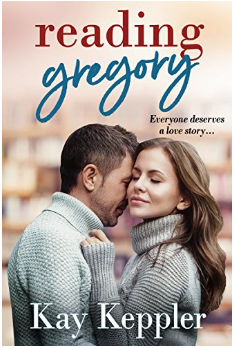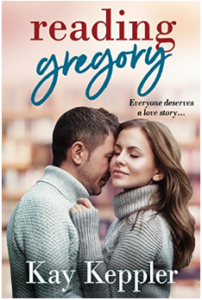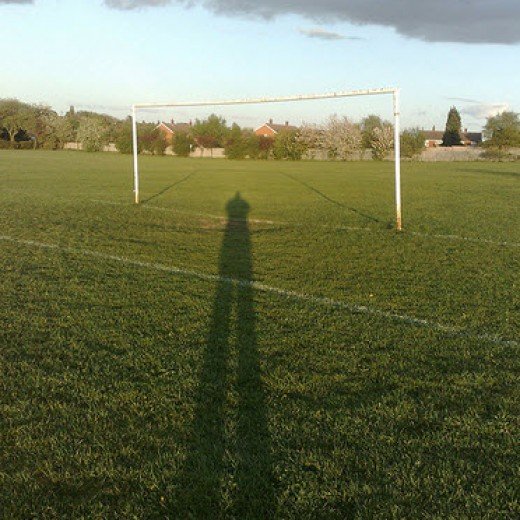Selling Your Book to Readers by Kay Keppler
 Let’s welcome back monthly columnist, editor, and novelist, Kay Keppler, as she shares with us “Selling Your Book to Readers.” Enjoy!
Let’s welcome back monthly columnist, editor, and novelist, Kay Keppler, as she shares with us “Selling Your Book to Readers.” Enjoy!
***
The best way to sell a book—and to give readers a chance to love your work—is to write a great book. That’s why we talk about writing craft so often.
However, other factors, especially your cover, play a role in attracting readers. The cover can—or should—tell your reader a lot about what’s inside. It’s the first opportunity for a book buyer to think, I want to read this one.
Going Pro or DIY
Hiring cover designers, however, can be pricey, especially for authors just starting out. The temptation to go cheap or even DIY can be overwhelming, especially if sales are uncertain. This was my dilemma with a novella I wanted to release, a story called Reading Gregory.
I’ve worked at book and magazine publishing companies for a long time, and I have some—not many, but some—skills in cover design. I downloaded the trial version of InDesign and went to work. Here’s the result (that little box around the heart disappears when published):
This cover isn’t ideal. I don’t know Photoshop, so I couldn’t insert a background, and the result looks amateurish.
Still, it gets the job done more or less. Some beta readers said the cover looked too much like a business or self-help book, but they knew it wasn’t a romance, since there’s no couple on the cover.
Here’s why: Gregory, the man in my story, is not the protagonist, but he’s the character whom my heroine reaches out to, the person she must figure out how to “read.” He’s the one who deserves the love story, which is my tagline.
So I went with that cover. I enjoyed some sales. I got a great review.
When Cheap or DIY Isn’t Enough
But after a while, I had a change of heart. That cover was weak, and these stories are all my babies, right? I love them all equally. They all have given me joy and made me sweat tears. So why shouldn’t they all have nice covers?
I cruised the internet, looking at the portfolios of cover designers. I wanted something warm, something romance-y without looking erotic, and something simple. I can’t afford original art, but graphic designers can do a lot with stock images.
I saw handsome covers for $700 that weren’t my style. I saw beautiful covers for $200 that were.
I saw attractive pre-made covers, where the artist lays out everything but your title and name, for $50 and even less.
I wanted to spend on the low end of custom covers, so I searched until I found a portfolio I liked in my price range, and then I contacted the designer.
Working with a Designer
I’ve hired designers before, many times, for my books and other projects in my day job, but I found this experience to be more interesting than usual. I filled out the questionnaire the designer sent me about the book (story summary, tone or mood of book, themes, my color preferences for the cover, and so on).
The key part of my story summary is that a bookseller corresponds by email for a while with a customer. The bookseller is going out of business, and the customer is recovering from his wife’s death. These two meet in person only on the last page of the book, and they decide to go for dinner. That’s it.
I helped the designer search for images. I’d thought at first that a cover without a couple would be best, since the story isn’t a courtship story. Melody didn’t like the images I found.
She asked me to think about the final product and to look for finished covers of other books that conveyed the emotion I wanted to convey, which was one of warmth, familiarity, closeness, kindness, and/or affection.
Convey an Emotion, not a Fact
Of course, the covers I found that conveyed those emotions all had people—couples—as the central image. I know from past experience that putting people on the cover of anything is almost always a better choice.
But in the case of this story, I thought a photo of a couple—especially an embracing couple—would be inaccurate, and I didn’t want to give readers a false impression of what they’d get.
Melody said, what about your other books? How do you identify as a writer?
There’s an interesting question. I identify as a romance writer, even though I can’t sell my books to editors and agents as traditional romances because many of my books aren’t courtship stories, or the courtship plot isn’t the main plot. But the romantic element is why I write these books in the first place. I believe in the HEA.
Promote Your Author Brand
Melody said, think of your author brand. If you identify as a romance author, and the courtship plots are important—if not critical—to your work, you should put a couple on the cover because it solidifies your brand. And I agreed with her.
We were a long way from finished, however. I’m down with the couple now, but I wanted to find an image similar to what I’d found on another cover—that of a couple standing in a gazebo, both of them laughing, but not in an embrace. It’s fall, and there’s an amber glow to the image.
That look really worked for me—they’re encircled by the gazebo, clearly together, but not yet embracing in a warm-looking environment.
Did I find such a photo? No. Not even close.
Do Your Best with Stock Images
Melody found an image she liked of a couple, but I thought the woman looked too young. I found an image I liked, but we decided the guy looked too giddy. She found an image we both liked well enough, where the guy might have gray in his hair.
We could have looked forever, and we would not have found an image we both were really excited about. There just aren’t that many images of people obviously in their thirties who are simply having fun.
There are oodles of photos of a man and woman in an office setting. And there are oodles of clinch shots. And there are oodles of photos where a man and a woman are doing things that are not in my book at all—moving furniture, petting a dog, drinking champagne.
Maybe that author or her editor had set up a photoshoot to get those two laughing people in the gazebo. It wouldn’t surprise me.
Choosing from Samples
Melody used the image we agreed on and created three covers from which I could choose:
As you see, two are blue-ish, and one has a sepia tint. I picked the sepia tint because it’s warmer, and the book, while not a comedy, is light-hearted. I thought the sepia would convey that better. The bookstore look and feel is minimized in the background, which I think is effective.
I love the script typeface in the title, and Melody matched the typeface for my name to the “reading” in the title. (Two typefaces are usually considered to be the limit for most covers. The tagline here is in the same font, but bold italic.)
Covers: A Different Kind of Craft
So that’s how and why I got a new cover. If you’re an indie or hybrid author, as many of you are, you’ll want to consider some or all of these issues when you’re ready to publish. Your mileage may vary from my experience, of course, but these are questions and issues you’ll be resolving—before your readers discover what a great book is behind that beautiful cover.
***
ABOUT THE AUTHOR
Kay Keppler is an author Zero Gravity Outcasts, Betting on Hope, Gargoyle: Three Enchanting Romance Novellas, and editor of fiction and nonfiction –Angel’s Kiss and Outsource It!
is an author Zero Gravity Outcasts, Betting on Hope, Gargoyle: Three Enchanting Romance Novellas, and editor of fiction and nonfiction –Angel’s Kiss and Outsource It!
She lives in northern California. Contact her here at Writer’s Fun Zone in the comments below, or at kaykeppler@yahoo.com to ask questions, suggest topics, or if you prefer, complain.











